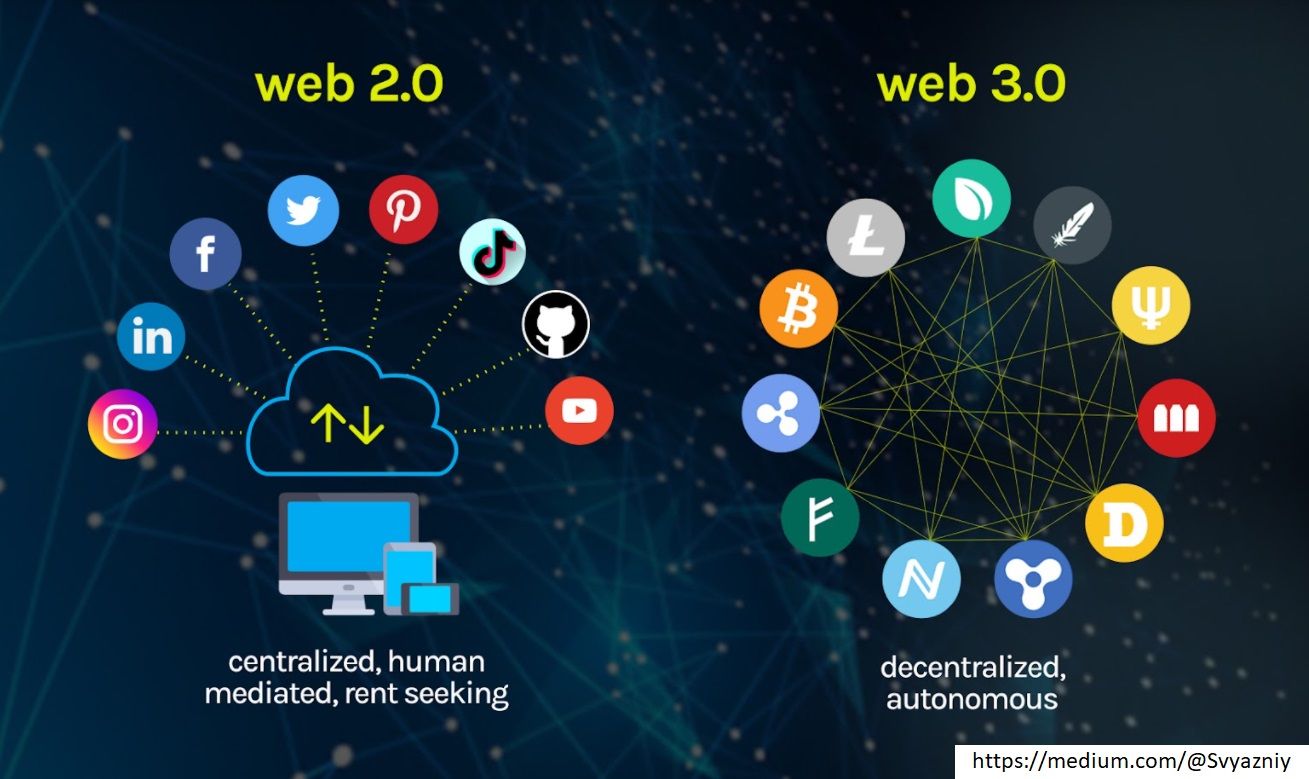The path from the Bitcoin whitepaper to the bustling ecosystem of Web3 technology has been nothing short of revolutionary. In this guide, we trace the evolution of digital currencies as they pave the way for the Web3 frontier—a new internet paradigm underpinned by blockchain technology and decentralized ideals.
This guide aims to provide a comprehensive understanding of Web3 technology. We’ll delve into the web3 meaning, web3 projects, web3 domains, explore its foundational concepts, and examine how to invest in web3. As we unpack the essence of Web3, we’ll reveal why it’s not just a technological leap, but also a cultural and economic revolution, poised to reshape the internet as we know it.
Introduction To Web3 Technology
In the rapidly evolving landscape of the digital world, Web3 technology emerges as a groundbreaking paradigm shift, redefining how we interact with the internet. Rooted in the principles of decentralization, transparency, and user empowerment, it represents a significant leap from the traditional, centralized web—often referred to as Web2.At the core of Web3 lies blockchain technology, the same innovative force that brought cryptocurrencies like Bitcoin into the limelight. However, it extends far beyond just digital currencies. It encompasses a wide array of decentralized applications (dApps), smart contracts, and a new generation of internet services and platforms that operate autonomously and are not controlled by any single entity.
Web3 Meaning: A Comprehensive Guide
The web3 meaning captures the essence of a decentralized online ecosystem underpinned by blockchain technology. It is an umbrella term that encapsulates an internet where users have sovereign control over their data, identities, and transactions. This vision for the next web generation stands on the pillars of decentralization, openness, and greater user utility.
Web3 Definition
Web3 is defined as the third generation of the internet, characterized by decentralized networks that utilize blockchain technology and token-based economics. It’s a shift from consuming content to owning and contributing to the network’s assets and operations. This succinct web3 definition encompasses a future where the internet operates autonomously, enabled by distributed ledger technology, and is free from the control of centralized authorities.
The Evolution from Web1 To Web2 To Web3.0
The digital world has undergone a significant transformation from Web1 to Web2, and now to Web3.0, each phase marking a pivotal shift in how the internet is structured and utilized. This evolution can be seen as a journey from static web pages to interactive experiences, and finally to a decentralized, user-driven web.
Web1 Meaning
Web1, often referred to as the ‘Static Web,’ was the internet’s first iteration. It was characterized by static websites that were purely informational and offered limited interaction. During this era, content was created by a small group of producers and consumed by the users, who had no direct way to contribute or alter the information. The key aspect of Web1 was its simplicity and ease of access to information, laying the foundation for the more interactive web that followed.Web2 Meaning
Web2, also known as the ‘Social Web,’ revolutionized the internet by introducing interactivity, social networking, and user-generated content. This era saw the rise of platforms like Facebook, YouTube, and Twitter, where users not only consumed content but also contributed to it, creating a more dynamic and collaborative web experience. The shift to Web2 brought about significant changes in how people connect, share, and communicate online, paving the way for a more connected global community.Web3 Meaning
Web3.0, or simply Web3, represents the next phase in the evolution of the internet. This iteration is defined by its decentralized nature, leveraging blockchain technology and token-based economics. It’s a paradigm shift from the centralized platforms of Web2, giving users unprecedented control over their data and online interactions. Web3:// is a concept that exemplifies this change, indicating a move towards a more secure, private, and user-empowered web. Web3 introduces concepts like decentralized finance (DeFi), non-fungible tokens (NFTs), and decentralized autonomous organizations (DAOs), signaling a significant leap towards a more open, transparent, and equitable internet.Web3 Explained: Beyond The Basics
Delving deeper into the realm of Web3, it’s crucial to move beyond the basics and understand the intricate mechanisms that define this new digital epoch. It’s about a transformative shift in how we perceive and interact with the web—a shift toward a more decentralized, transparent, and user-centric online world.How Web3.0 Is Changing The Internet Landscape
Web3.0, often simply referred to as Web3, is dramatically altering the internet landscape. This transformation stems from its decentralized nature, distributing power and control across the network instead of centralizing it in the hands of a few dominant players. This shift in control signifies not just a technological change but a fundamental shift in digital power dynamics. It ushers in an era of increased privacy, enhanced security, and greater user sovereignty, making the internet a more equitable and participatory space. It’s an exciting time, as Web3 opens up new possibilities for creative and economic freedom online. Moreover, it also has the potential to fundamentally disrupt the Web2 business models of platforms like Facebook.
Disrupting Traditional Business Models
Web3’s approach to data ownership and user empowerment directly threatens the established Web2 models. In the Web2 ecosystem, typified by platforms like Facebook, user data is a commodity. These platforms collect and monetize user information through targeted advertising, creating revenue streams heavily reliant on user data. Web3, however, introduces a paradigm where users have full control over their data. Through blockchain technology, Web3 enables individuals to own and monetize their data, participate in governance, and directly benefit from their contributions to the network. This shift in data ownership and control represents a seismic shift in how online business models function. For instance, in a Web3-based social media platform, users could earn tokens for their content, engagement, and community contributions. These tokens could represent actual stake in the platform, giving users not just a say in how the platform evolves, but also a share in the economic benefits. This model starkly contrasts with Web2 platforms, where user activity generates value that primarily benefits the platform owners. It’s model of shared ownership and profits poses a significant threat to the traditional ad-revenue-driven models of Web2 companies.Impact On Established Tech Giants
Let’s consider a hypothetical scenario where a major platform like Facebook faces a Web3 competitor. In this scenario, the Web3 platform empowers users with control over their data, allowing them to opt into advertising schemes voluntarily and transparently. Users could even earn a share of the advertising revenue generated by their data. This transparency and profit-sharing model could attract users away from traditional platforms, compelling companies like Facebook to rethink their data and revenue strategies. Moreover, the application of decentralized autonomous organizations (DAOs) introduces a governance model that is more democratic and user-influenced. Users of a DAO-driven platform can propose, vote on, and implement changes to the platform, directly influencing its direction and policies. This level of user involvement and control is unprecedented in the Web2 landscape and could lead to a more user-centric and ethical online platform.Web3 Is Going Great: Explained
The phrase “Web3 Is Going Great” refers to a by Molly White, a crypto researcher & critic, software engineer, Wikipedian which is called “Web3 is Going Just Great”. White’s website serves as a critical ledger, chronicling the various scams and fraudulent activities within the crypto and Web3 space. As of November 2023, the site’s ‘Grift Counter’ has tallied a staggering $69.52 billion in financial losses due to these nefarious activities.
Some of the latest examples of frauds covered on the “Web3 Is Going Great” site include:
- Monero Community Crowdfunding Wallet Drained: Monero, focused on privacy, encountered a significant setback when its community crowdfunding system (CCS) was compromised and entirely drained, losing about 2675.73 XMR (approximately $460,000), funded by donations.
- Safemoon Executives Charged For Fraud: The executives behind Safemoon, a crypto token which had its all time high market cap in April 2021 with $17 billion, were charged with defrauding investors. They promised a secure investment but engaged in practices like removing tokens from the liquidity pool, leading to significant financial losses for investors.
- Infringement Lawsuit In The NFT Space: A notable case in the NFT realm involved Ryder Ripps and Jeremy Cahen, who were ordered to pay $1.6 million in a lawsuit over creating identical NFTs to the Bored Ape collection.

Key Web3 Projects And Innovations
Web3 is fostering a multitude of innovative projects across various domains. These platforms stand out, revolutionizing traditional financial systems with decentralized lending, borrowing, and trading. Similarly, decentralized autonomous organizations (DAOs) offer a new model for organizational governance using blockchain technology. Gaming and NFTs (Non-Fungible Tokens) are also significant sectors. Play-to-earn gaming models have emerged, where players can earn cryptocurrency or NFTs through gameplay. These games often incorporate blockchain to ensure true ownership of in-game assets. Moreover, Web3 is also seeing growth in decentralized social media platforms, where users have control over their data and can earn from their online interactions. These platforms challenge the centralized model of current social media giants by offering more privacy and reducing dependency on advertising revenue models. Another niche is domain services.Spotlight On Prominent Projects
In the vast and varied landscape, certain projects stand out for their innovative contributions and foundational roles in shaping the future of decentralized technology. These projects, which range from infrastructural frameworks to user-centric applications, are not only pioneers in the space but also serve as the building blocks for a new era of the internet. Let’s explore some of the most influential Web3 projects that are leading the charge in this digital revolution.Ethereum
Ethereum stands as the foundational backbone for a multitude of projects. As a decentralized platform, it not only supports its native cryptocurrency, Ether (ETH), but also enables the creation and operation of decentralized applications (dApps) and smart contracts. Its flexibility and widespread adoption have made it a primary choice for developers in the space.Solana
Solana gained recognition for its high throughput and fast transaction speeds, favoring its use as a platform for dApps, particularly in the DeFi and NFT sectors. Its unique consensus mechanism combines proof-of-stake with proof-of-history, offering an efficient and scalable solution.Chainlink
Chainlink is a decentralized oracle network that provides real-world data to smart contracts on the blockchain. It plays a crucial role in the functioning of many decentralized applications, particularly in DeFi, by securely and reliably connecting these apps with off-chain data and services.Filecoin
Filecoin is a decentralized storage network that allows users to rent out their spare digital storage space. It’s an innovative solution for decentralized data storage, competing with traditional cloud storage providers by offering a more secure and transparent storage ecosystem.Brave Browser
Brave Browser integrates Web3 functionalities directly into its interface. As a privacy-focused browser, it blocks trackers and ads by default, while also offering users the opportunity to earn Basic Attention Tokens (BAT) for viewing privacy-respecting ads.Uniswap
Uniswap is a leading decentralized exchange (DEX) operating on the Ethereum blockchain. It uses an automated liquidity protocol, eliminating the need for traditional order books and allowing users to swap ERC-20 tokens directly from their wallets.Decentraland
Decentraland is a virtual reality platform powered by the Ethereum blockchain. It enables users to create, experience, and monetize content and applications within a virtual world. Decentraland provides a digital landscape where users can purchase and develop virtual plots of land, referred to as LAND tokens. It’s a unique blend of gaming, real estate, and digital art, allowing for a fully immersive virtual experience.
The Sandbox
The Sandbox is another prominent virtual world that leverages blockchain technology. It’s a community-driven platform where creators can monetize voxel assets and gaming experiences on the Ethereum blockchain. In The Sandbox, users have control over their creations and can buy, sell, or trade assets in the form of NFTs. It’s a platform that combines the creative aspects of game design with the financial opportunities of blockchain technology.Web3 Domains And Their Impact
Domain names are undergoing a revolutionary transformation. A Web3 domain is essentially a domain name registered on a blockchain network, such as Ethereum. These domain names serve multiple functions in the decentralized web.What Is A Web3 Domain?
A Web3 domain is more than just an internet address. It’s a versatile tool within the blockchain ecosystem. These domains can be used to send and receive cryptocurrency payments, access decentralized applications (dApps), and interact with smart contracts. Unlike traditional crypto addresses, which are long and complex strings of characters, Web3 domains provide a human-readable alternative. This simplifies transactions and interactions, making them more user-friendly.Transforming Digital Identity And Enhancing Security
Web3 domains represent a significant leap in how digital identities are managed. They provide users with a consistent, portable identity across different services. This feature is particularly valuable in the world of dApps and decentralized finance (DeFi), where seamless interaction is crucial. Web3 domains enhance security and control, as they are immune to censorship and external interference. Being blockchain-based, they offer a level of decentralization and resilience that traditional domains cannot match. This aspect is critical in an era where digital autonomy and privacy are paramount.How Web3 Search Engines Reshape Online Search
Web3 search engines, such as W3C, are redefining the landscape of online search with a focus on privacy, decentralization, and user control. Unlike traditional search engines that centralize data and often use it for targeted advertising, Web3 search engines utilize blockchain technology to ensure user privacy and data sovereignty. These web3 search engines are still evolving but are driven by the vision of a more unbiased and open internet. They aim to provide users with greater control over their digital identities and data, challenging the current norms of data ownership and usage in the online search domain.The Role Of Web3 Auth In Security
Web3 auth systems, like Ethereum’s ENS (Ethereum Name Service) or uPort, offer a decentralized approach to user authentication, using blockchain technology for enhanced security. They rely on public-private key cryptography, granting users complete control over their digital identities. This decentralization mitigates risks associated with centralized data repositories, such as data breaches. Web3 auth is integral to building trust and security in the Web3 ecosystem, emphasizing user sovereignty over personal data and offering a more secure, privacy-focused alternative to traditional authentication methods.How To Invest In Web3
For those new to the space, investing can seem daunting, but it offers exciting opportunities. The first step is understanding the basics of blockchain technology and the types of assets available, including cryptocurrencies, NFTs (Non-Fungible Tokens), and tokens associated with specific Web3 projects. Beginners should start by investing small amounts in well-established decentralized applications. It’s also crucial to use reputable exchanges and wallets for transactions and storage, and to stay updated with the latest trends and developments in the space.A Beginner’s Guide: How To Access Web3
For newcomers to Web3, understanding how to connect and interact with decentralized applications (dApps) is fundamental. The key to this interaction is a crypto wallet, which acts as your digital identity and gateway to the Web3 world. MetaMask is the most popular browser extension wallet and it is widely used for its ease of use and integration with Ethereum-based applications. Alternatively, privacy-focused browsers like Brave offer built-in wallets, providing an additional layer of security and convenience.












